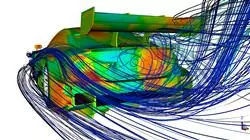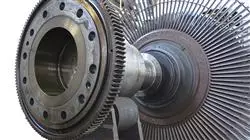University certificate
The world's largest faculty of engineering”
Introduction to the Program
Thanks to this Postgraduate certificate, you will be able to establish hypotheses on turbulent viscosity”

Turbulence and Boundary Layer Modeling is a discipline of great importance in sectors such as aerospace engineering, automotive, marine and energy industries. Thus, engineers trained in this area can design and analyze systems and devices to reduce flow resistance, improve energy efficiency, minimize environmental impacts and improve process safety.
For this reason, the demand for engineers trained in this sector is growing steadily and more and more organizations are hiring these professionals. In this sense, there is a growing need for professionals trained in this area to meet the demands of the industry. Thus, the graduate will be able to access numerous job opportunities in a variety of industries, where he/she will be able to contribute significantly to the development of technology and improve efficiency and sustainability in processes and devices.
For all these reasons, TECH has created an academic degree in which the graduate will delve into the problem of chaos and the energy cascade, as well as the turbulence cycle. All this under a comfortable 100% online modality, which allows you to adapt your study time and combine it with your personal and professional work. In addition, the program's methodology focuses on providing the student with a complete, practical and efficient education under the most effective methodology, Relearning.
A curriculum in which the contents are presented in an attractive and dynamic way to turn you into a first level engineer”
This Postgraduate certificate in Turbulence and Boundary Layer Modeling contains the most complete and up-to-date program on the market. The most important features include:
- The development of case studies presented by experts in Textile Engineering
- The graphic, schematic, and practical contents with which they are created, provide practical information on the disciplines that are essential for professional practice
- Practical exercises where self-assessment can be used to improve learning
- Its special emphasis on innovative methodologies
- Theoretical lessons, questions to the expert, debate forums on controversial topics, and individual reflection assignments
- Content that is accessible from any fixed or portable device with an Internet connection
The teaching system offered by TECH will allow you to organize your time and pace of learning, adapting it to your schedule”
The program’s teaching staff includes professionals from sector who contribute their work experience to this educational program, as well as renowned specialists from leading societies and prestigious universities.
Its multimedia content, developed with the latest educational technology, will provide the professional with situated and contextual learning, i.e., a simulated environment that will provide an immersive education programmed to learn in real situations.
The design of this program focuses on Problem-Based Learning, by means of which the professional must try to solve the different professional practice situations that are presented throughout the academic course. This will be done with the help of an innovative system of interactive videos made by renowned experts.
You will be able to access the contents from any device with an internet connection 24 hours a day"

This is your opportunity to access the best theoretical and practical contents of the academic panorama, only in the TECH library"
Why study at TECH?
TECH is the world’s largest online university. With an impressive catalog of more than 14,000 university programs available in 11 languages, it is positioned as a leader in employability, with a 99% job placement rate. In addition, it relies on an enormous faculty of more than 6,000 professors of the highest international renown.

Study at the world's largest online university and guarantee your professional success. The future starts at TECH”
The world’s best online university according to FORBES
The prestigious Forbes magazine, specialized in business and finance, has highlighted TECH as “the world's best online university” This is what they have recently stated in an article in their digital edition in which they echo the success story of this institution, “thanks to the academic offer it provides, the selection of its teaching staff, and an innovative learning method aimed at educating the professionals of the future”
A revolutionary study method, a cutting-edge faculty and a practical focus: the key to TECH's success.
The most complete study plans on the university scene
TECH offers the most complete study plans on the university scene, with syllabuses that cover fundamental concepts and, at the same time, the main scientific advances in their specific scientific areas. In addition, these programs are continuously being updated to guarantee students the academic vanguard and the most in-demand professional skills. In this way, the university's qualifications provide its graduates with a significant advantage to propel their careers to success.
TECH offers the most comprehensive and intensive study plans on the current university scene.
A world-class teaching staff
TECH's teaching staff is made up of more than 6,000 professors with the highest international recognition. Professors, researchers and top executives of multinational companies, including Isaiah Covington, performance coach of the Boston Celtics; Magda Romanska, principal investigator at Harvard MetaLAB; Ignacio Wistumba, chairman of the department of translational molecular pathology at MD Anderson Cancer Center; and D.W. Pine, creative director of TIME magazine, among others.
Internationally renowned experts, specialized in different branches of Health, Technology, Communication and Business, form part of the TECH faculty.
A unique learning method
TECH is the first university to use Relearning in all its programs. It is the best online learning methodology, accredited with international teaching quality certifications, provided by prestigious educational agencies. In addition, this disruptive educational model is complemented with the “Case Method”, thereby setting up a unique online teaching strategy. Innovative teaching resources are also implemented, including detailed videos, infographics and interactive summaries.
TECH combines Relearning and the Case Method in all its university programs to guarantee excellent theoretical and practical learning, studying whenever and wherever you want.
The world's largest online university
TECH is the world’s largest online university. We are the largest educational institution, with the best and widest online educational catalog, one hundred percent online and covering the vast majority of areas of knowledge. We offer a large selection of our own degrees and accredited online undergraduate and postgraduate degrees. In total, more than 14,000 university degrees, in eleven different languages, make us the largest educational largest in the world.
TECH has the world's most extensive catalog of academic and official programs, available in more than 11 languages.
Google Premier Partner
The American technology giant has awarded TECH the Google Google Premier Partner badge. This award, which is only available to 3% of the world's companies, highlights the efficient, flexible and tailored experience that this university provides to students. The recognition as a Google Premier Partner not only accredits the maximum rigor, performance and investment in TECH's digital infrastructures, but also places this university as one of the world's leading technology companies.
Google has positioned TECH in the top 3% of the world's most important technology companies by awarding it its Google Premier Partner badge.
The official online university of the NBA
TECH is the official online university of the NBA. Thanks to our agreement with the biggest league in basketball, we offer our students exclusive university programs, as well as a wide variety of educational resources focused on the business of the league and other areas of the sports industry. Each program is made up of a uniquely designed syllabus and features exceptional guest hosts: professionals with a distinguished sports background who will offer their expertise on the most relevant topics.
TECH has been selected by the NBA, the world's top basketball league, as its official online university.
The top-rated university by its students
Students have positioned TECH as the world's top-rated university on the main review websites, with a highest rating of 4.9 out of 5, obtained from more than 1,000 reviews. These results consolidate TECH as the benchmark university institution at an international level, reflecting the excellence and positive impact of its educational model.” reflecting the excellence and positive impact of its educational model.”
TECH is the world’s top-rated university by its students.
Leaders in employability
TECH has managed to become the leading university in employability. 99% of its students obtain jobs in the academic field they have studied, within one year of completing any of the university's programs. A similar number achieve immediate career enhancement. All this thanks to a study methodology that bases its effectiveness on the acquisition of practical skills, which are absolutely necessary for professional development.
99% of TECH graduates find a job within a year of completing their studies.
Postgraduate Certificate in Turbulence and Boundary Layer Modeling
In-depth knowledge of turbulent flow is essential in many areas of engineering and applied physics. In particular, turbulence modeling is a critical topic in the numerical and experimental simulation of complex flows. At TECH Global University, we have developed the Postgraduate Certificate in Turbulence and Boundary Layer Modeling, a comprehensive training that addresses the fundamental concepts of fluid mechanics and turbulence modeling, as well as the practical aspects and applications in engineering. This program has been designed to provide students with a thorough and up-to-date understanding of turbulence models and their implementation in different simulation techniques, including CFD (Computational Fluid Dynamics).
This undergraduate program is designed to provide students with a thorough and up-to-date understanding of turbulence models and their implementation in different simulation techniques, including CFD (Computational Fluid Dynamics).
This Postgraduate Certificate addresses key issues in the research and development of turbulence modeling techniques, including detailed description of different turbulence models, evaluation of their performance and their application in practical situations. In addition, special attention is given to the boundary layer, a critical aspect in many industrial and environmental flows. Upon completion of the program, students will be able to understand and apply the most suitable turbulence models for a wide variety of engineering problems, and will be able to perform numerical simulations of turbulent flows with high accuracy and efficiency.







